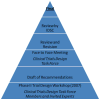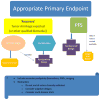The design of phase II clinical trials testing cancer therapeutics: consensus recommendations from the clinical trial design task force of the national cancer institute investigational drug steering committee
- PMID: 20215557
- PMCID: PMC2840069
- DOI: 10.1158/1078-0432.CCR-09-3287
The design of phase II clinical trials testing cancer therapeutics: consensus recommendations from the clinical trial design task force of the national cancer institute investigational drug steering committee
Abstract
The optimal design of phase II studies continues to be the subject of vigorous debate, especially studies of newer molecularly targeted agents. The observations that many new therapeutics "fail" in definitive phase III studies, coupled with the numbers of new agents to be tested as well as the increasing costs and complexity of clinical trials, further emphasize the critical importance of robust and efficient phase II design. The Clinical Trial Design Task Force (CTD-TF) of the National Cancer Institute (NCI) Investigational Drug Steering Committee (IDSC) has published a series of discussion papers on phase II trial design in Clinical Cancer Research. The IDSC has developed formal recommendations about aspects of phase II trial design that are the subject of frequent debate, such as endpoints (response versus progression-free survival), randomization (single-arm designs versus randomization), inclusion of biomarkers, biomarker-based patient enrichment strategies, and statistical design (e.g., two-stage designs versus multiple-group adaptive designs). Although these recommendations in general encourage the use of progression-free survival as the primary endpoint, randomization, inclusion of biomarkers, and incorporation of newer designs, we acknowledge that objective response as an endpoint and single-arm designs remain relevant in certain situations. The design of any clinical trial should always be carefully evaluated and justified based on characteristic specific to the situation.
Figures



Similar articles
-
Design of phase I combination trials: recommendations of the Clinical Trial Design Task Force of the NCI Investigational Drug Steering Committee.Clin Cancer Res. 2014 Aug 15;20(16):4210-7. doi: 10.1158/1078-0432.CCR-14-0521. Clin Cancer Res. 2014. PMID: 25125258 Free PMC article. Review.
-
Approaches to phase 1 clinical trial design focused on safety, efficiency, and selected patient populations: a report from the clinical trial design task force of the national cancer institute investigational drug steering committee.Clin Cancer Res. 2010 Mar 15;16(6):1726-36. doi: 10.1158/1078-0432.CCR-09-1961. Epub 2010 Mar 9. Clin Cancer Res. 2010. PMID: 20215542 Free PMC article.
-
Guidelines for the development and incorporation of biomarker studies in early clinical trials of novel agents.Clin Cancer Res. 2010 Mar 15;16(6):1745-55. doi: 10.1158/1078-0432.CCR-09-2167. Epub 2010 Mar 9. Clin Cancer Res. 2010. PMID: 20215558
-
An overview of the optimal planning, design, and conduct of phase I studies of new therapeutics.Clin Cancer Res. 2010 Mar 15;16(6):1710-8. doi: 10.1158/1078-0432.CCR-09-1993. Epub 2010 Mar 9. Clin Cancer Res. 2010. PMID: 20215546 Review.
-
Impact of the 2010 Consensus Recommendations of the Clinical Trial Design Task Force of the NCI Investigational Drug Steering Committee.Clin Cancer Res. 2015 Nov 15;21(22):5057-63. doi: 10.1158/1078-0432.CCR-15-0035. Clin Cancer Res. 2015. PMID: 26567365 Free PMC article.
Cited by
-
A phase II study of conventional radiation therapy and thalidomide for supratentorial, newly-diagnosed glioblastoma (RTOG 9806).J Neurooncol. 2013 Jan;111(1):33-9. doi: 10.1007/s11060-012-0987-0. Epub 2012 Oct 20. J Neurooncol. 2013. PMID: 23086432 Clinical Trial.
-
Molecularly targeted agents as radiosensitizers in cancer therapy--focus on prostate cancer.Int J Mol Sci. 2013 Jul 16;14(7):14800-32. doi: 10.3390/ijms140714800. Int J Mol Sci. 2013. PMID: 23863691 Free PMC article. Review.
-
Envisioning the future of early anticancer drug development.Nat Rev Cancer. 2010 Jul;10(7):514-23. doi: 10.1038/nrc2870. Epub 2010 Jun 10. Nat Rev Cancer. 2010. PMID: 20535131 Review.
-
Shortcomings in the clinical evaluation of new drugs: acute myeloid leukemia as paradigm.Blood. 2010 Oct 7;116(14):2420-8. doi: 10.1182/blood-2010-05-285387. Epub 2010 Jun 10. Blood. 2010. PMID: 20538802 Free PMC article.
-
More randomization in phase II trials: necessary but not sufficient.J Natl Cancer Inst. 2011 Jul 20;103(14):1075-7. doi: 10.1093/jnci/djr238. Epub 2011 Jun 27. J Natl Cancer Inst. 2011. PMID: 21709273 Free PMC article. No abstract available.
References
-
- Adjei A, Christian M, Ivy P. Novel Designs and End Points for Phase II Clinical Trials. Clin Cancer Res March 15. 2009;15:1866–1872. - PubMed
-
- Dhani N, Tu D, Sargent DJ, Seymour L, Moore MJ. Alternate Endpoints for Screening Phase II Studies. Clin Cancer Res. 2009;15:1873–1882. - PubMed
-
- Shankar LK, Van den Abbeele A, Yap J, Benjamin R, Scheutze S, FitzGerald TJ. Considerations for the Use of Imaging Tools for Phase II Treatment Trials in Oncology. Clin Cancer Res. 15:1891–1897. - PubMed
Publication types
MeSH terms
Substances
Grants and funding
LinkOut - more resources
Full Text Sources
Medical
Miscellaneous

